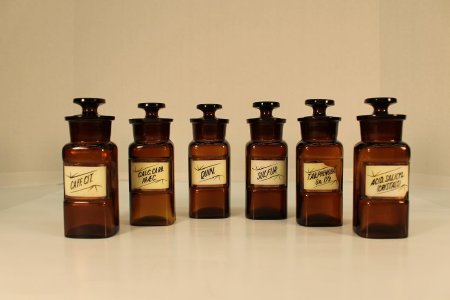Object ID Number:
ph109
Object Name:
Bottles
Type:
Shop Furniture
Manufacturer:
Whitall Tatum Company – Millville, NJ
Manufactured from:
1900
Manufactured to:
1920
Description / History:
There are six amber glass bottles in this collection. They are mold–blown and have embossments on the bottom indicating that these bottles were manufactured by Whitall Tatum Company, a leading glass manufacturing company in Millville, New Jersey. The "W.T.Co" markings on the base date them between 1900 and 1920. The bottles are empty, but each has a label indicating the original contents and a glass stopper.
Bottle A: Has the label "Caff. Cit." which is short for Caffeine Citrate. This medication was used for the short–term treatment of apnea, a breathing problem, in premature infants. The caffeine blocks certain proteins (adenosine receptors) leading to improved breathing. It is also a stimulant that can be used to stay awake.
Bottle B: Has the label "Calc. Carb. Praec." short for Precipitated Calcium Carbonate. It is a fine white powder. It was used externally as a drying agent on moist eczema and hyperidrosis. It was used internally as a remedy for diarrhea and an antacid.
Bottle C: Has the label "Quin." short for Quinine. It is a white powder that naturally occurs in the bark of the Cinchona tree. It was the first effective Western treatment for malaria.
Bottle D: Has the label "Sulfur'' which is a yellow crystal. This element is used in medications to treat acne, dandruff, and warts. It is effective due to its keratolytic (peeling of the layers of the skin), antibacterial, and antifungal properties.
Bottle E: Has the label "Tab. Phenobarb. Gr. 1 1/2" short for Phenobarbital tablets of 1.5 grain. Phenobarbital was first used in 1912 for its sedative and antiepileptic properties. Today, it is the most widely used anticonvulsant worldwide to treat epileptic seizures.
Bottle F: Has the label "Acid. Salicyl. (Crystals)". Salicylic acid is historically derived from plants like the bark of the white willow tree. It is used in anti–acne products and antidandruff shampoo. Furthermore, aspirin is derived from salicylic acid.
Bottle A: Has the label "Caff. Cit." which is short for Caffeine Citrate. This medication was used for the short–term treatment of apnea, a breathing problem, in premature infants. The caffeine blocks certain proteins (adenosine receptors) leading to improved breathing. It is also a stimulant that can be used to stay awake.
Bottle B: Has the label "Calc. Carb. Praec." short for Precipitated Calcium Carbonate. It is a fine white powder. It was used externally as a drying agent on moist eczema and hyperidrosis. It was used internally as a remedy for diarrhea and an antacid.
Bottle C: Has the label "Quin." short for Quinine. It is a white powder that naturally occurs in the bark of the Cinchona tree. It was the first effective Western treatment for malaria.
Bottle D: Has the label "Sulfur'' which is a yellow crystal. This element is used in medications to treat acne, dandruff, and warts. It is effective due to its keratolytic (peeling of the layers of the skin), antibacterial, and antifungal properties.
Bottle E: Has the label "Tab. Phenobarb. Gr. 1 1/2" short for Phenobarbital tablets of 1.5 grain. Phenobarbital was first used in 1912 for its sedative and antiepileptic properties. Today, it is the most widely used anticonvulsant worldwide to treat epileptic seizures.
Bottle F: Has the label "Acid. Salicyl. (Crystals)". Salicylic acid is historically derived from plants like the bark of the white willow tree. It is used in anti–acne products and antidandruff shampoo. Furthermore, aspirin is derived from salicylic acid.
3D Image Information:
The 3 dimensional image can be viewed using Google Chrome, Safari, or Firefox browsers.
3 Dimentional Image:
